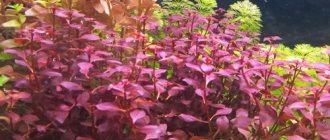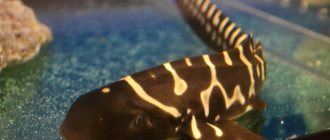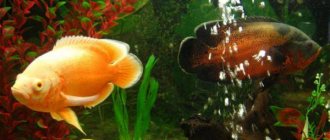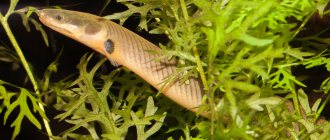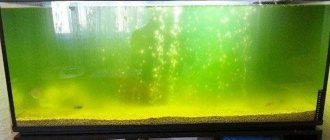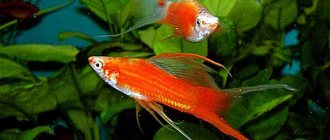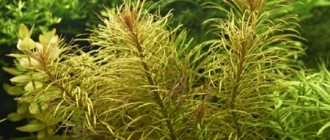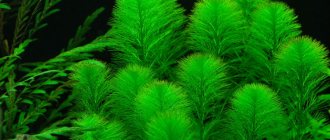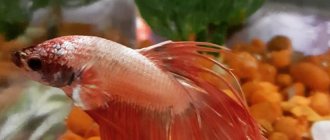Description
To decorate aquariums, the tiger water lily or nymphea lotus is most often used. Under natural conditions, this plant is found in West Africa.
The shape of the leaves of the aquarium water lily is heart-shaped. Their shade varies from dark red to light green. There are purple or brown spots on the leaves. As soon as sunlight hits them, their shade will change to purple on the reverse side.
The height of the aquarium plant reaches 20–70 cm. The length of the leaf is about 12–15 cm. In the center of the water lily there is a rosette from which the leaves extend.
Tiger water lily blooms in early summer. If you create appropriate conditions for maintenance, you can admire flowers of pink or light pink color.
Nymphea in nature
Under natural conditions, the water lily prefers swamps and ponds. Natural specimens are divided by size:
Bushes that grow up to 70 cm in height are considered small; the largest ones grow up to 1.5 m. The size of the petioles depends on the place of growth. Some water lilies are awake during the day, others show buds at night. There are flowers that are simple in structure, others have a huge number of petals and resemble asters and peonies.
Flower colors vary:
Natural representatives have powerful root processes up to 5 cm in diameter. There are species adapted to winter cold (pure white, white, small), but most cannot tolerate cold winters.
Kinds
Various types of nymphs are used to fill the aquarium. Before planting, experienced aquarists study the description.
Rudge
This variety has round leaves. Their hue is pinkish-green. The number of leaves depends on the volume of the selected tank and the amount of water. In winter, the plant practically does not grow.
Mikranta
Nymphaeum leaves are located both under water and on the surface. Their shade ranges from green to red-green. The height of the plant is about 30–35 cm. As soon as the above-water leaves appear, a peduncle is formed.
Stellata
It stands out because the leaves are significant in size and have a reddish tint.
Such vegetation should be planted on a substrate that includes useful components. Only in this case is a flower formed, the diameter of which is about 13–14 cm.
The color of the flowers ranges from white to red. The edging of the flowers is lighter.
Viviparous
The color of the leaves of the aquarium plant is rich green with burgundy dots. For such a nymph, water of varying hardness and acidity is suitable.
Tiger green
These species are distinguished by large and richly green leaves. During the flowering period, a small flower appears that has a white tint.
Tiger red
Nymphea red is distinguished by leaves that have an olive and bright green tint. Burgundy patterns are concentrated around the perimeter.
Content
Keeping a nymph requires compliance with certain rules. If the nymph is grown incorrectly, it rots quickly enough and the root system is destroyed.
For planting, tanks with a wall height of 50 cm or more are used.
Water parameters:
- The height of the water column is about 40–45 cm.
- The degree of hardness is about 2–4 units.
- Slightly acidic environment – 6 units.
- Temperature – from 22 to 28 degrees.
To fill the bottom, substrates are used, which include humic acids and mineral fertilizers.
Some species can also be planted in containers containing water of increased hardness. But in this case, the tiger water lily grows in breadth, forming a bush. Flowers do not appear on such a bush.
The fluid in the reservoir is changed once every 2–3 weeks. About 20–25 percent are replaced.
Lighting
In order for the tiger water lily to develop normally, efficient lighting equipment is required. The lighting units include fluorescent lamps or phytolamps. Lighting units are located at a certain distance in order to preserve views.
Daylight hours are 12–14 hours. If possible, place the container with the lily so that the sun's rays fall on it. This contributes to the normal development of the plant.
For normal development, aerators and compressors are introduced into the tank with tiger water lilies. In order to prevent rapid destruction of the root system, these units are used carefully. In order to saturate aquarium water with oxygen, aerators are used, which are characterized by low productivity.
Beautiful types of aquarium nymphs and caring for them
Nymphea cannot be called an unpretentious aquarium plant. You will need additional equipment and powerful lighting. Growing water lilies requires experience in maintaining aquarium plants.
Landing
To plant a nymph, you will need an aquarium at least 50 cm in height, filled with at least 40 cm of water.
The water lily will need soft water (2–14 dGH). In a more rigid one, the nymph will exist without flowering. pH value 5–7. The water lily does not like frequent water changes. It’s better to do 20–25% once every two weeks.
Temperature
Nymphea survives at temperatures from 15 to 30 degrees. Blooms from 22 degrees.
Microclimate
Maintain the microclimate of the aquarium. Take care of heating the water in cold weather. A thermometer is required. The presence of oxygen dissolved in water is desirable. To do this, place a low-power compressor or pump. Make sure that the aeration process does not shake the water too much.
- clay;
- small pebbles;
- black soil;
- sand.
- mineral;
- humic acids;
- iron salts;
- bone meal.
Top dressing
Lighting
Place lighting fixtures at a sufficient distance from the surface of the water. Avoid using incandescent lamps: they are low wattage and heat up the water too much. LED and fluorescent lamps are suitable. The plant benefits from sunlight, but in the aquarium, under the influence of such light, weed algae develop. Create 12-14 hours of daylight.
Every aquarium fish lover dreams of having an amazing plant in his aquarium that looks like a lotus flower. Many people want to know how nymphs are grown, planted and cared for. For an aquarium, these processes have their own specifics, since this plant mainly grows in ponds and reservoirs. In another way it is also called water lilies.
This plant surprises with its unusual beauty and size. Therefore, its owners need to make a lot of effort to preserve its existence for a long time.
Such troubles do not scare anyone, because the result is worth it. Therefore, aquarists are not afraid to breed such plants in aquariums.
It looks so gorgeous from the outside! Nymphaeum flower varieties, planting and care, photos will be discussed in this article.
Since nymphs are very large plants, to breed them you will need to purchase a large aquarium. When the water lily grows, its leaves occupy almost all the free space in the container; their shape is very similar to the Latin letter V.
Today there are three known types of nymphs, the planting and care of which is adapted to aquariums. They are most common throughout the planet and are actively grown by aquarists.
Nymphea sizes
Depending on the location of large leaves, petioles will grow to a certain length. They seem to be trying to find at least a little free space for themselves. The largest petiole height that exists in the world is one and a half meters. But this is not direct evidence that if a plant reaches such a size, then it does not need careful care.
In order for the water lily to fit in the aquarium, experts have learned to slightly delay its growth. In such cases, nymphs can only grow up to fifty centimeters.
Red water lily
Tiger or red nymphs are most suitable for home growing conditions. Planting and caring for this species does not differ in specifics, except for the availability of sufficient space.
The tiger nymph is very different in appearance from its relatives. After all, it has an unusually interesting color. Its leaves can be either bright green or soft olive green.
Also on its wide leaves there are beautiful patterns of a brown-burgundy hue.
The red water lily is a plant that was once grown artificially. Its leaves are colored dark burgundy and red. A young plant is absolutely different from a more mature one, because their leaves have very different shapes and sizes. The leaves of a young water lily are slightly oval and do not yet have a characteristic cutout in the middle.
The red nymph, whose care and planting in the aquarium requires a large amount of free space, grows to the edges of the aquarium and occupies about half a meter of area.
The leaves of adult plants can float on the surface of the water, or they can remain submerged.
This species blooms and is propagated mainly by basal shoots.
We suggest you read: Cornish Rex cat care
Burgundy water lily
This type of plant has bright burgundy leaves, which attracts aquarium enthusiasts, and grows almost forty centimeters in height.
This type of plant is a very beautiful nymph. Planting and caring for it is quite simple, which is why many aquarists purchase it. Unfortunately, due to their rather impressive size, no more than two of these plants can fit in an aquarium. To enable the nymph to grow and reproduce normally, it is better to provide it with as large an area as possible for growth.
If you have the desire and opportunity to breed such a plant, then you should not refuse it.
After all, this will provide an opportunity to observe the most unusual processes that occur in the aquatic world, and in this case, directly in the owner’s home.
Nymphaeas will be able to bring lightness and beauty to your home, creating the impression of some kind of fairyland, which many have only seen in cartoons!
The simplest plants that do not require constant attention are green nymphs. Planting and caring for them can be done well at home. This water lily can grow up to sixty centimeters. It grows and multiplies quite quickly, so it is necessary to get rid of new shoots in a timely manner.
The leaves of the plant are small in size and do not grow very quickly, being located over the entire area of the aquarium. The leaves of tiger nymph grow on tall petioles that come from the very powerful root system of the plant. Their appearance is quite standard for the genus of nymphs; they have small slits in the center.
The leaves can reach enormous sizes only if there is not enough water in the aquarium. Such plants are very reminiscent of the most common water lilies that are found in reservoirs and ponds.
Tiger nymphs can also reproduce vegetatively. For the normal development of this plant, it must be fed with special feed, which should contain a large amount of useful microelements.
For the normal growth of nymphs, which are planted and cared for in an aquarium, the container must contain high-quality soil, which will include a lot of organic substances. It will also not be superfluous to add charcoal, clay, peat. It is best for the stones to be medium in size. After all, large pebbles will only harm the leaves of the water lily.
Also, for planting nymphs, for greater convenience, you can use a regular flower pot, just remember to take into account the size of the plant.
After all, if fish live in an aquarium, this will give them the opportunity to move between the leaves of plants and receive additional useful microelements.
It is very important to be informed about the fact that the aquarium tiger nymph, which is generally not difficult to plant and care for, is quite sensitive to light.
When the plant does not have enough light, the stems of its leaves will begin to gradually rise up and weaken.
After a couple of days, the leaves will change their bright green color to a duller one, which can result in the death of the water lily.
When it is not possible to enjoy real light during the day, fluorescent lamps come to the rescue; in this case, phytolamps will have the best effect.
Using them allows you to increase the growth rate of plants, if this is, of course, necessary for the owner of the flower.
What is also important to consider is what quality of water will be used to fill the aquarium.
The maximum hardness of water should not exceed six degrees, and the acidity of the liquid must be maintained no higher than seven. Otherwise, the same situation as in the example with a lack of sunlight may repeat.
The most optimal water temperature in an aquarium is considered to be from twenty-four to twenty-eight degrees. If for some reason the water temperature drops to twenty-two degrees, the plant immediately notices this: it begins to slowly wither and stops growing.
Also good news is that the water in the aquarium where the plant is growing does not need to be changed very often. On the contrary, if the water is a little stagnant, then humic acids will begin to accumulate in it, which take an active part in the process of growth and development of the water lily. The most suitable filling level for an aquarium with a nymph is no less than forty-five centimeters.
The plant is characterized by two methods of reproduction. The first occurs using seeds, and the second is a vegetative method. In this case, new small shoots will appear on the roots of the plants. If their growth begins to exceed fifteen centimeters, then it is recommended to transplant them into a separate aquarium or pot filled with soil.
Growing
Water lilies reproduce by seeds and shoots that extend from the root system. The shoots form after the plant has flowered. They are disconnected from the root system and transplanted into a container with an appropriate substrate. This procedure brings certain benefits. If you do not remove excess thickets, the likelihood of normal development will decrease.
Planting and care are performed in a certain sequence. A container is prepared for the nymph in which an optimal alkaline and acid balance is maintained. The temperature of the liquid is about 26–27 degrees.
Seeds are also used for breeding nymphs. To obtain them, flowers are carefully pollinated in the autumn. For these purposes, prepare a brush, with which the axils of the leaves are treated. This procedure is performed until the leaves bloom.
Once the seeds are collected, experienced aquarists begin breeding seedlings. To do this, they prepare containers that are filled with peat and treated water. After the shoots appear, a substrate with the required components is added to the tank. This process requires some effort and time. But when done correctly, aquarists get high-quality shoots.
Tiger nymph is a popular aquarium plant. It blooms actively in summer and autumn. In winter, vegetation practically does not develop. In order to admire the flowers and gorgeous leaves, they create the appropriate conditions for development.
Video about the proper cultivation and reproduction of nymphs in an aquarium
AdminAuthor of the article
Did you like the article?
Share with your friends:
Reproduction of water lilies
The reproduction process of this species is labor-intensive and complex. The plant reproduces by seeds only in its natural environment, but it is quite difficult to do this yourself. The reason is that they are not designed for dry storage.
The desire to breed a water lily can only be satisfied by choosing a vegetative method. In this case, the root is taken out of the water and divided into several parts. It is important that each part has one or more buds. To “treat” the cut area, sprinkle it with charcoal. The speed of such procedures should be maximum, since drying out of the rhizome must be avoided. After dividing, each part is placed in a container with sludge at the bottom and the water lily is expected to grow.
